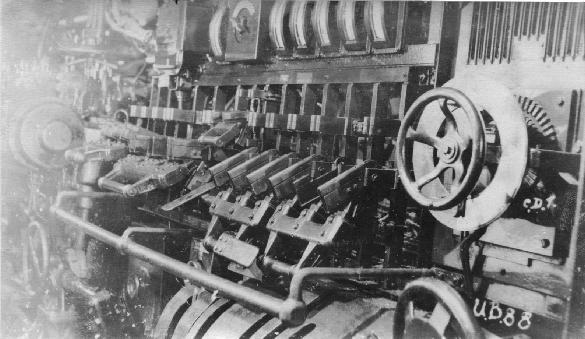UB-88
| Other Names: | Date of Sinking: January 3, 1921 | |||
| Rig/Type: WWI UB Class German Submarine | Cause of Sinking: Shellfire (target vessel) | |||
| Length: 182' | Breadth: 19' | Tons: 510 | Cargo: None | |
| Built: 1917 | Location: San Pedro Bay | |||
| Hull Construction: Steel | Depth: ? | Visibility: ~40-60' | ||

Commissioned on January 26, 1918, the UB-88 was 182’ in length, 19’ in beam and 510 tons. She is credited with sinking 16 allied vessels during her nine months of service. At the end of the war, the sub was one of six submarines turned over to the United States. Under command of the US Navy, the UB-88 crossed the Atlantic in April of 1919 and began its coastal tour to promote the sales of war bonds.
 |
Four of the U-boats turned over the US at the end of WWI are tied alongside each other in New York's Navy Yard, sometime between April 27 and May 5, 1919. The UB-88 can be seen in the center of the photo. |
 |
The UB-88 transits the Panama Canal, accompanied by the sub tender, USS Bittern. |


Left: Five of the American engineering crew pose next to the UB-88's
6 cylinder engines. Right: The UB-88's four bow torpedo tubes.

The sub visited ports on the East Coast, the Gulf Coast, sailed up the Mississippi River, transited the Panama Canal, and sailed up north along the coast to Washington, finally returning to Los Angeles on November 8, 1919. Beginning April 1 of 1920, the sub was partially dismantled.
| Tourists inspect the UB-88. | |
 |
The UB-88's engines.
(Photo by Harry Wayne Fields, courtesy of Carolyn Snider) |
 |
The Electical Control Panel
(Photo by Harry Wayne Fields, courtesy of Carolyn Snider) |
|
Torpedo Tubes (Photo by Harry Wayne Fields, courtesy of Carolyn Snider)
Gauges. Right: Three different views of the UB-88's Control Board. |

|
|
|
|
| Despite the hopes of many divers, the UB-88 was extensively salvaged, as can be seen by the debris removed from the submarine left and above. The picture above and right showing her pistons removed is indicative of the degree of her stripping. (Photo by Harry Wayne Fields, courtesy of Carolyn Snider) |
On March 1 of the following year, the UB-88 was towed out to sea by the Pocomoke to be sunk in accordance with the treaty and to serve as "…a great moral lesson to those who think they can terrorize the world…" While the press and officials on board the New Mexico watched, the destroyer Wickes fired twenty four-inch rounds into the sub, destroying its conning tower and opening a "gaping hole" in the bow with several direct hits. A fire began on board and the sub took on a list. Finally, its bow dropped below the surface and the stern "…heaved high into the air…pointed straight for the skies, the diver paused for a moment, then sank quickly."
| This picture from the Los Angeles Times is likely the last picture taken of the UB-88. Photographed from the New Mexico, it shows the stern of the UB-88 lifting up out of the water as her bow plummets towards the bottom. |
Those who have dived the S-37 off San Diego can appreciate the size of the UB-88. Only 19’ in beam, the UB-88 is likely to have sunk into the bottom at a few feet, further reducing its profile to the searching scans of fathometers and sonar. The conning tower would be a fray of torn metal, resulting from a direct hit of a four-inch shell. The bow would also be in bad shape, having taken a direct hit from the Wickes and then from the impact of being driven into the ocean floor when it sank. The wood decks are gone and in the absence of the propellers, the whole sub may resemble a large riveted sewer pipe with a few shell holes. Many divers have surmised that the sub would hold all kinds of brass relics typically found on submarines. However, even before she left to cross the Atlantic, it was noted that "Much of the machinery was corroded and souvenir hunters had stripped the craft of some valuable instruments." Due to the limited supply of brass in Germany late in the war, little was used in the construction of the sub and the American crew experienced a number of failures and difficulties due to the extensive use of steel which quickly corroded. Of the few instruments, gauges, and other items made of brass, few, if any remain as they would have been removed during its dismantling in Los Angeles. Note that the UB-88 still has an unexploded scuttling charge consisting of 25 pounds of TNT.
A bronze paperweight cast from the propellers of the UB-88.
A handful of fortunate collectors have already acquired pieces of brass from the UB-88. During its dismantling, the propellers were removed and melted down into paperweights. These paperweights were cast in the silhouette of the UB-88 and measure approximately 5 ½" inches in length. The paperweights occasionally show up for sale in the Los Angeles area and E-bay. One of the paperweights can be seen on display at the Los Angeles Maritime Museum.






